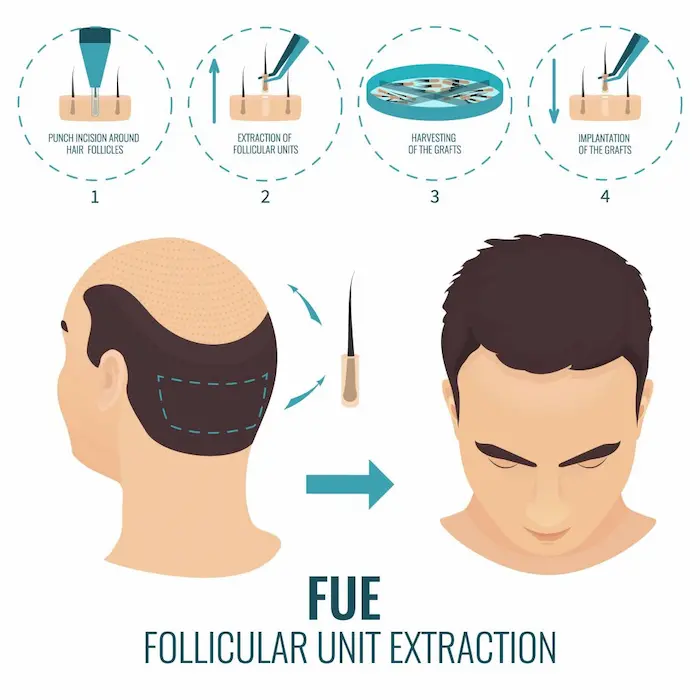
FUE Hair Transplant: The Revolutionary Solution for Hair Restoration
Hair loss affects millions of individuals worldwide, impacting their self-esteem and overall quality of life. Fortunately, advancements in medical technology have provided innovative solutions to combat this problem.
Hair loss affects millions of individuals worldwide, impacting their self-esteem and overall quality of life. Fortunately, advancements in medical technology have provided innovative solutions to combat this problem. Follicular Unit Extraction (FUE) hair transplant is one such breakthrough that has revolutionized the field of hair restoration. In this article, we will delve into the intricacies of FUE hair transplant, exploring its procedure, benefits, potential risks, and overall effectiveness.
Understanding FUE Hair Transplant
Follicular Unit Extraction (FUE) is a modern and innovative hair transplant technique that has gained significant popularity in recent years. It is a minimally invasive surgical procedure designed to restore hair in areas affected by hair loss or thinning. FUE differs from traditional hair transplant methods by offering a minimally invasive approach and yielding natural-looking results.
The FUE procedure begins with the administration of local anesthesia to ensure patient comfort. Next, the surgeon utilizes a small punch tool, typically ranging from 0.6mm to 1.0mm in diameter, to extract individual hair follicles. The FUE procedure involves the extraction of individual hair follicles from a donor area, typically located at the back of the scalp. These donor follicles are genetically resistant to hair loss and are carefully selected to ensure successful transplantation.
After the extraction, the surgeon creates small incisions in the recipient sites, the area where the hair is to be transplanted. These sites are strategically placed to mimic the natural growth pattern and density of the patient's existing hair. The extracted follicles are then carefully implanted into the recipient sites one by one using forceps or other precision instruments.
The extraction process is performed using a specialized tool, such as a punch or a microsurgical instrument, which creates tiny circular incisions around each follicle. These incisions are usually less than 1mm in diameter.
Recovery and Postoperative Care
Guiding patients on postoperative care and the recovery process is crucial for optimal results. This section can cover:
a) Dressing and Bandaging: Discussing the use of dressings or bandages immediately after the surgery and their removal timeline.
b) Managing Discomfort: Providing tips for managing postoperative discomfort, such as pain medications, cold compresses, and avoiding strenuous activities.
c) Washing and Care Instructions: Explaining when and how to start washing the scalp after the procedure, as well as any specific care instructions provided by the surgeon.
d) Shedding and Re-growth: Informing patients about the normal shedding of transplanted hair within the first few weeks and reassuring them that new hair growth will follow.
Advantages of FUE Hair Transplant
FUE hair transplant offers several advantages over traditional hair restoration techniques. These benefits have contributed to its increasing popularity among both patients and hair transplant surgeons.
a) Minimally Invasive Procedure: FUE is a minimally invasive procedure that requires no stitches or sutures, resulting in less scarring and faster recovery time compared to other methods.
b) Natural-Looking Results: The individual extraction of hair follicles allows for precise placement, resulting in a more natural-looking hairline and overall hair restoration. The ability to select specific follicles also enables the transplantation of hair from other body areas if necessary.
c) Reduced Discomfort: FUE causes minimal discomfort during and after the procedure, making it a preferred choice for individuals who are apprehensive about surgical interventions.
d) Faster Healing and Recovery: The absence of sutures accelerates the healing process, allowing patients to return to their daily activities more quickly. Most patients can resume normal activities within a few days after the procedure.
e) Minimal Scarring: FUE leaves tiny, almost imperceptible scars at the donor site, making it a suitable option for individuals who prefer to wear shorter hairstyles.
Potential Risks and Considerations
While FUE hair transplant is generally safe, it is essential to consider potential risks and complications before undergoing the procedure.
a) Postoperative Swelling and Bruising: Some patients may experience temporary swelling and bruising in the recipient and donor areas, which usually subside within a few days or weeks.
b) Risk of Infection: As with any surgical procedure, there is a minimal risk of infection. Following the postoperative instructions provided by the surgeon significantly reduces this risk.
c) Donor Site Scarring: Although FUE leaves minimal scars, some patients may develop visible scars or uneven texture at the donor site. However, these issues are rare and can be mitigated by an experienced surgeon.
d) Limited Donor Hair Supply: FUE relies on the availability of healthy hair follicles in the donor area. Individuals with advanced hair loss or insufficient donor hair may not be ideal candidates for this procedure.
e) Cost Considerations: FUE is generally more expensive than traditional hair transplant methods due to its meticulous and time-consuming nature. Patients should weigh the benefits and costs to make an informed decision.
Effectiveness and Long-Term Results
FUE hair transplant has proven to be highly effective in restoring natural hair growth and improving overall appearance. The transplanted hair follicles typically go through a shedding phase before re-growing new hair within a few months. Over time, the transplanted hair becomes indistinguishable from the surrounding hair, providing a permanent and aesthetically pleasing outcome.
It is important to note that FUE may not be suitable for everyone. The success of the procedure depends on various factors, including the patient's individual characteristics, the extent of hair loss, the availability of healthy donor hair, the skill and experience of the surgeon, and adherence to postoperative care instructions. Results can vary from person to person, and it is crucial to maintain realistic expectations. Consulting with a qualified hair transplant surgeon is crucial to determine whether FUE is the most appropriate option for addressing one's specific hair loss concerns.
Conclusion
Follicular Unit Extraction (FUE) hair transplant has emerged as a groundbreaking solution for individuals seeking a permanent remedy for hair loss. Its minimally invasive nature, natural-looking results, and faster recovery time make it an attractive choice for many. While risks and considerations exist, they can be mitigated through careful patient selection and a skilled surgeon. By carefully selecting and implanting individual hair follicles, FUE provides a successful and aesthetically pleasing outcome, restoring both hair and confidence to those who undergo the procedure.
If you are considering a hair transplant, consult with a qualified professional to assess your suitability for the FUE procedure and explore the potential benefits it can offer in restoring your hair and confidence. You can make communication easier with the finest surgeons in India by contacting them through our website via email or WhatsApp, with just a few clicks.


Comments
Login & Write comment